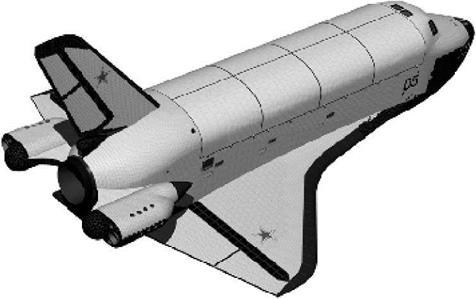The OK-92
The new launch vehicle was called RLA-130. While there were still four strap-on boosters with 600-ton RD-123 engines, the three 250-ton thrust RD-0120 engines were now on the “external tank’’ rather than on the orbiter. The overall launch mass was the same as that of the OS-120 (2,380 tons), but the orbiter now weighed just 116.5 tons at launch as compared with 155.35 tons for the OS-120.
Now devoid of main engines, the OK-92 orbiter was to be equipped instead with two kerosene-fueled D-30KP turbojet engines mounted in external pods on either side of the aft fuselage. Widely used on the Ilyushin-62 passenger airliner, these would have to give the orbiter more flexibility in reaching the runway. Also, with a shorter landing roll-out (2.5-3 km vs. 4 km for the OS-120), the vehicle could land on many ordinary runways in the USSR. The engine inlets and outlets would be protected from the vacuum of space and the heat of re-entry by jettisonable covers. The engines were to be activated at an altitude of between 5 and 8 km.
The orbital maneuvering engines and aft reaction control thrusters were now installed in pods adjacent to those housing the D-30KP engines. The nozzles of the forward reaction control thrusters were protected during launch and re-entry by a special cover. As on the OS-120, the propellants to be used by the engines would be hypergolic. The orbital maneuvering engines were to be derived from the 15D619 engine used on the second stage of KB Yuzhnoye’s UR-100 ICBM. The ultimate goal, however, was to replace the toxic propellants by a combination of hydrogen peroxide (H2O2) and kerosene, the latter of which could then be used both by the
|
The OK-92 orbiter (source: www. buran. ru). |
D-30KP turbojet engines and the on-orbit propulsion system. For that combination engineers would draw on the experience gained with the RD-510, an H2O2/kerosene engine developed at Energomash for the lunar module of the canceled N-1/L-3M manned lunar project.
OK-92 retained a solid-fuel emergency escape system for early launch aborts, but it now consisted of a single engine installed under the vertical stabilizer. This would be jettisoned 56 seconds into the launch, after which the vehicle would have gained enough speed and altitude to reach the runway with its turbojet engines after an emergency separation from the rocket. In case they were needed in a launch abort, the D-30KP engines could be activated in about 30-50 seconds.
Another feature which set OK-92 apart from the US Orbiter was the use of two remote manipulator arms to deploy payloads from the cargo bay. It was also planned to use the arms in docking operations, pretty much like the Space Shuttle Endeavour used its mechanical arm to dock the Unity module with Zarya during the first Shuttle ISS assembly mission (STS-88) in 1998.
Prior to the maiden orbital mission, the Russians were planning to carry out an extensive series of atmospheric approach and landing tests. In the first stage many onboard systems (such as the propulsion and emergency escape engines, various cabin systems, the remote manipulator arms, etc.) were to be replaced by mock-ups and the vehicle could take off either on its own power or (if its mass was reduced to 60-80 tons) on the back of the An-22 “Antey” aircraft, which would then release it at an altitude of about 2 km. If the mass was reduced to 51-60 tons, the An-22 could also be used to transport the orbiter over a distance of about 2,000 km at an altitude of 2 km. Both for the drop tests and the ferry flights the OK-92’s D-30KP turbojet engines could be used to assist during take-off and the climb to cruise altitude.
For the second stage of the landing tests the OK-92 would be outfitted with most of the systems needed for orbital flight, including the propulsion system and the solid – fuel escape motor. Now too heavy to be carried by the An-22, the OK-92 would fly all the remaining atmospheric test flights on its own power. Plans called for using the combined thrust of the turbojet engines, orbital maneuvering engines, and the solid – fuel motor to take the vehicle to an altitude of 21km and a speed of 1,800 km/h (Mach 1.5) to simulate the final portion of its mission. This was far higher and faster than NASA had been able to do with Enterprise. At this point in time the Russians did not plan a dedicated atmospheric test vehicle, but one that would later be modified into a spaceworthy orbiter. At the time, NASA was planning to do exactly the same with Enterprise, until it was realized in late 1977 that it would be cheaper to turn Structural Test Article STA-099 into the second flight article (what became OV-099 Challenger).
The turbojet engines would also have allowed the OK-92 to fly on its own power to the Baykonur cosmodrome either from the manufacturer or from back-up runways. The range would have been 1,600 km at a cruise altitude of 3 km. However, that could have been increased to 3,000 km by increasing the fuel supply for the engines and using the emergency solid fuel motor as an afterburner on take-off [58].











